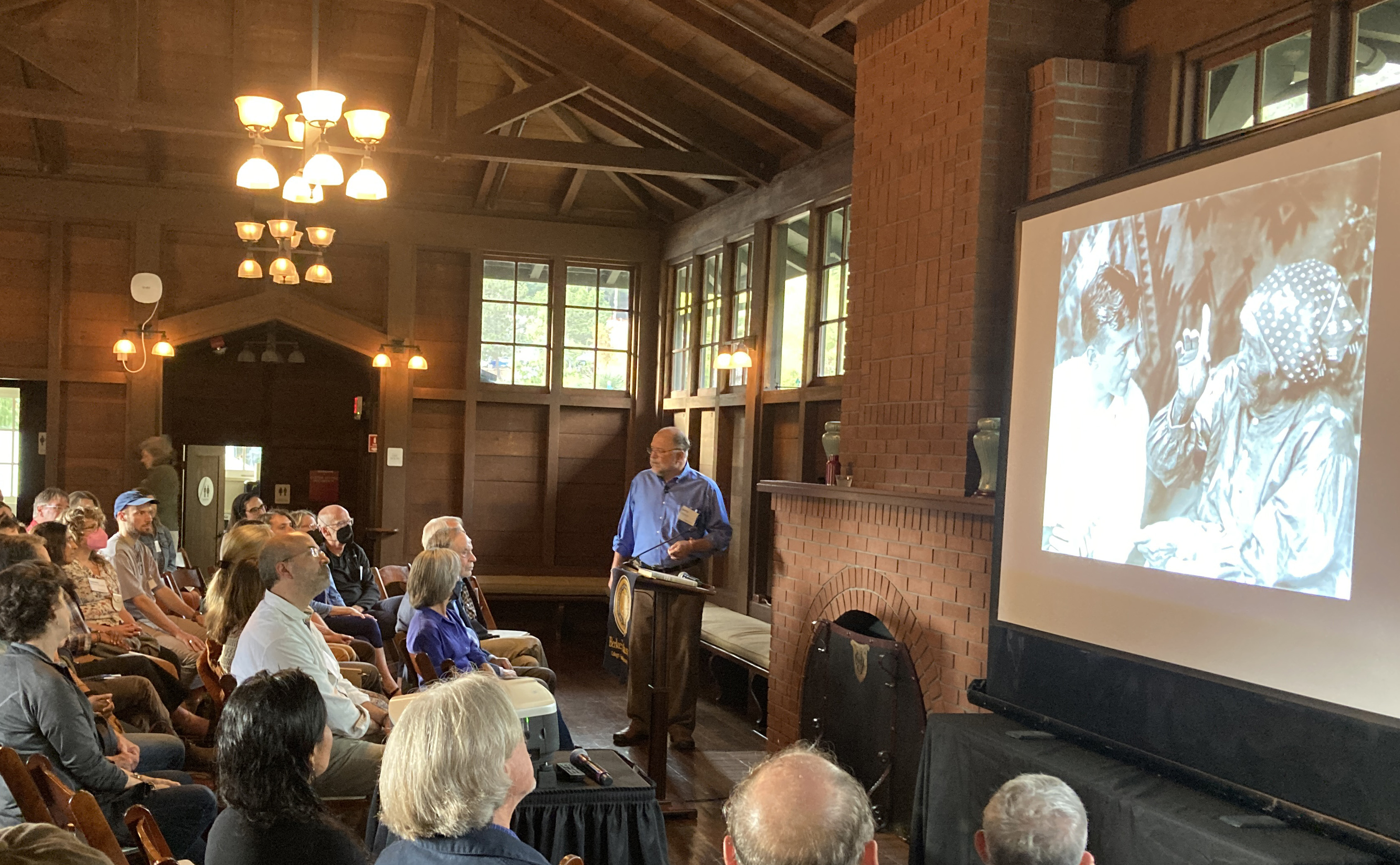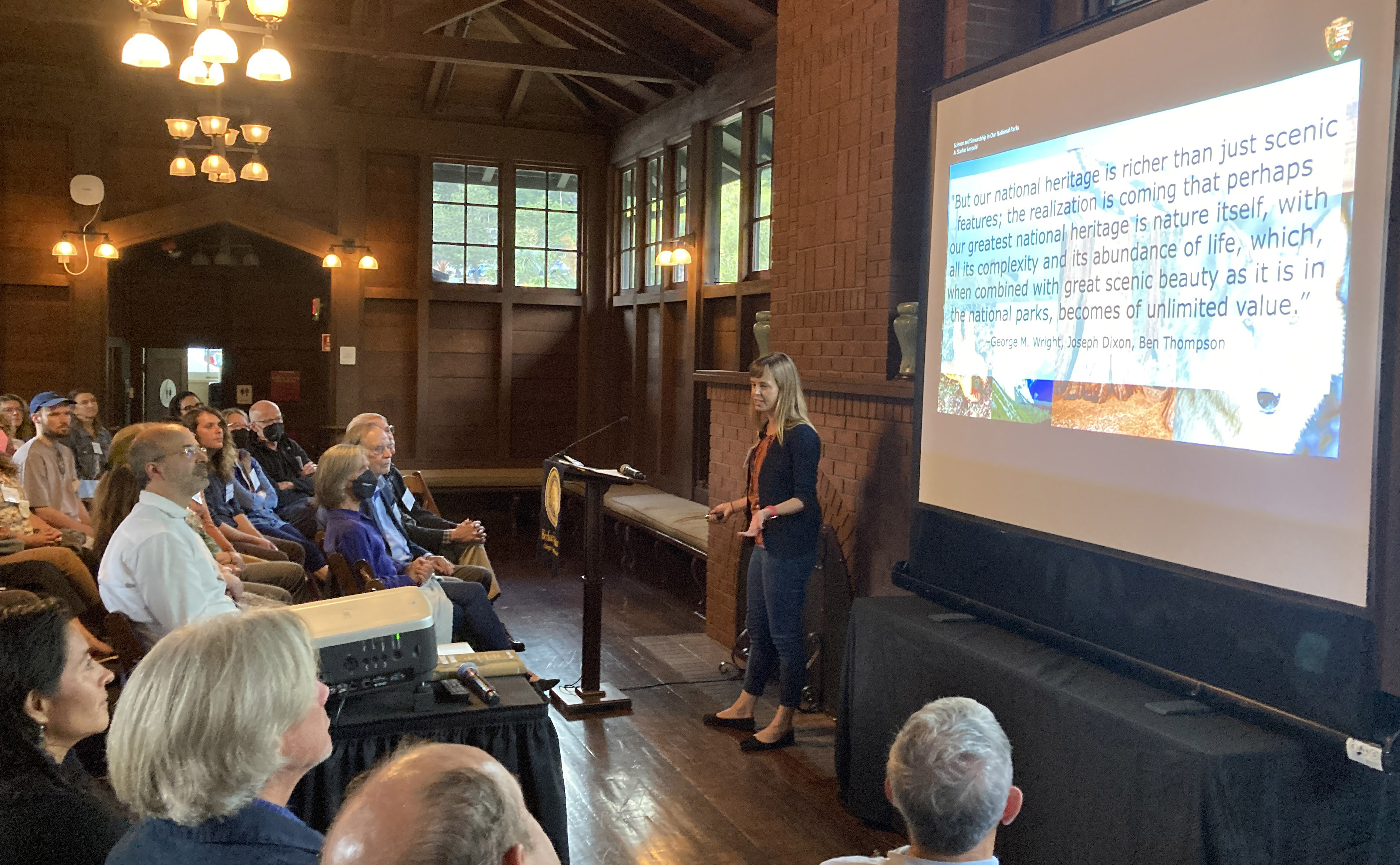Origins and Innovations of Science in the U.S. National Parks - Leopold Lecture 2023
The University of California, Berkeley, Institute for Parks, People, and Biodiversity presented the A. Starker Leopold Lecture “Origins and Innovations of Science in the U.S. National Parks,” September 27, 2023, at the University of California Botanical Garden. Conservation writer Jerry Emory and national park science leader Alison Forrestel, Ph.D., spoke. Patrick Gonzalez, Ph.D., climate change scientist and Executive Director of the Institute, moderated.

Jerry Emory presents a historical photograph of George Meléndez Wright and Maria Lebrado (Totuya), 1929, taken by Joseph Dixon. Modern photo by Patrick Gonzalez.

Alison Forrestel speaks in the Leopold Lecture. Photo by Patrick Gonzalez.
Jerry Emory recounted the origins of scientific management of wildlife in the U.S. national parks through the history of George Meléndez Wright (b. 1904, d. 1936), a wildlife biologist who earned his Bachelor of Science degree from UC Berkeley in 1927. George Wright and colleagues published the first scientific wildlife survey of the western U.S. national parks and established the U.S. National Park Service Wildlife Division, first located on campus in Hilgard Hall from 1931 to 1935.
This year, Jerry Emory published a biography of George Meléndez Wright. He has published five other books, including San Francisco Bay Shoreline Guide, and articles in National Geographic and other magazines. Jerry has worked for Save the Redwoods League, the California State Parks Foundation, and the Gordon and Betty Moore Foundation and earned his Master of Arts degree in geography from UC Berkeley.
Alison Forrestel, Ph.D., illustrated innovations in science for natural resource management in U.S. national parks today. Many new practices have emerged from a revisiting of the scientific work of A. Starker Leopold (more information below). She serves as Chief of Natural Resources and Science for Golden Gate National Recreation Area, a U.S. national park covering 320 square kilometers of land and water in and around San Francisco, California. She leads the implementation of science and management programs for landscape-scale conservation and ecological restoration.
Dr. Forrestel also leads the network of organizations working to conserve the Golden Gate Biosphere Reserve, an area covering 2100 square kilometers of the San Francisco Bay area, designated by the U.N. Educational, Scientific, and Cultural Organization for biodiversity conservation and sustainable human development. She has worked for the U.S. National Park Service for 20 years and earned her Doctor of Philosophy degree from UC Berkeley, conducting research on fire ecology in Point Reyes National Seashore and Crater Lake National Park.
A. Starker Leopold, Ph.D., (b. 1913, d. 1983) served on the faculty of UC Berkeley from 1946 to 1978, ultimately as Professor of Zoology and Forestry. In 1963, Dr. Leopold and colleagues published Wildlife Management in the National Parks, a key report that established goals for natural resource management that guided the parks for decades. In 1967, he concurrently served as Chief Scientist of the U.S. National Park Service. In 2012, the U.S. National Park System Advisory Board redefined the goals of resource management under climate change and other new challenges in the report Revisiting Leopold: Resource Stewardship in the National Parks.
A. Starker Leopold was the oldest child of Aldo Leopold (b. 1887, d. 1948), the conservationist and author of A Sand County Almanac, whose concept of a land ethic has inspired generations of people working to conserve our Earth.
We are grateful to Estella B. Leopold, youngest child of Aldo Leopold, for her generous funding of this lecture series.
